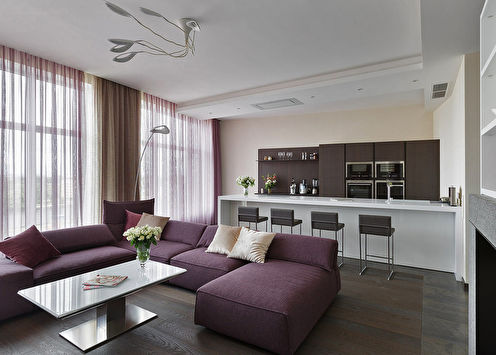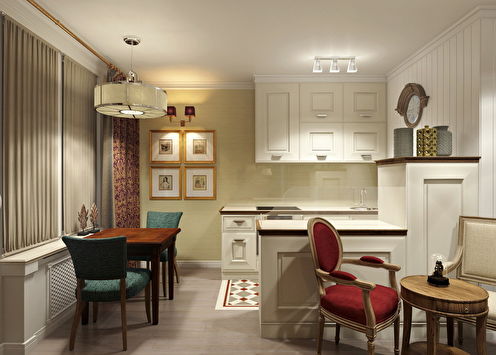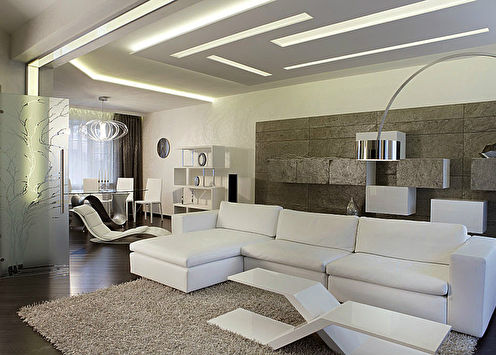
The lack of natural light in the home is a problem for many people. The reasons for this may be different: windows facing the northwest, the shade of other buildings, the prevalence of cold weather, or simply poor layout. To freely allow the rays of the sun to penetrate into all corners of housing, glass partitions were invented. Along with high light transmission, they significantly save space, making the apartment spacious and stylish.
Pros and cons of glass partitions
Initially, glass partitions could be seen mainly in offices and shopping centers, but now they are increasingly appearing in the design of residential premises. At first glance, it might seem that installing such fragile structures at home is a risky undertaking, especially in the presence of children or pets. However, experts argue that such fears are groundless: for interior partitions, toughened toughened or laminated glass is used, on which a film is additionally glued to prevent spattering of fragments in case of damage. A safer and cheaper analogue is the so-called acrylic glass (plexiglass, plexiglass), in fact - transparent plastic.

The advantages of glass partitions in the apartment are obvious: firstly, they take up much less space than brick or plasterboard partitions, while transmitting light; secondly, they delimit space without cluttering or decreasing the area; thirdly, they give the interior an ultramodern, fashionable look.
Glass perfectly combines with most finishing materials, but it looks especially harmonious next to monophonic glossy surfaces: a mirrored stretch ceiling, parquet polished to shine or perfectly smooth cabinet doors.
Transparent walls are the best solution for studio apartments, lofts and attics, decorated in a modern, industrial, as well as Scandinavian style. However, with the help of a special decor they can be beaten in other areas of design - from restrained classics to extravagant boho.
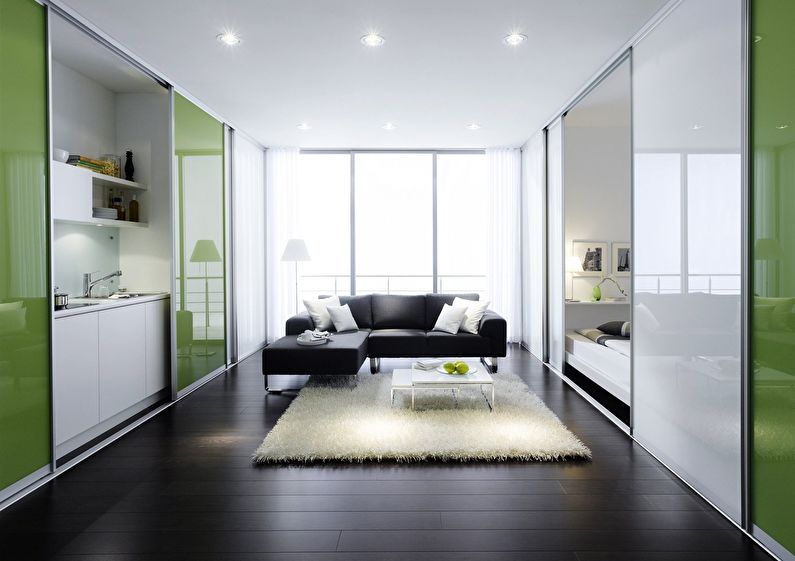
Installing a glass partition does not apply to redevelopment, unless one of the internal brick walls is demolished before that. By itself, this design is considered an element of furniture, even if it takes place from floor to ceiling and crosses the entire apartment.
Full-sized closable partitions, especially multilayer ones (duplex, triplex), have good sound insulation and prevent the penetration of odors. Both glass and its plastic imitations are resistant to moisture, mold does not start on them, and any dirt can be easily washed off. This is an environmentally friendly and practical material, which, with careful operation, will last for many years without requiring repair or repainting.
Perhaps the only drawback of glass partitions is again their transparency. Not everyone will like the openness of their private rooms, especially if it is a bedroom or a bathroom. In addition, penetrating light, for example, from the living room, can interfere with sleep. To some extent, greater privacy can be achieved with matte partitions, blackout curtains or blinds.
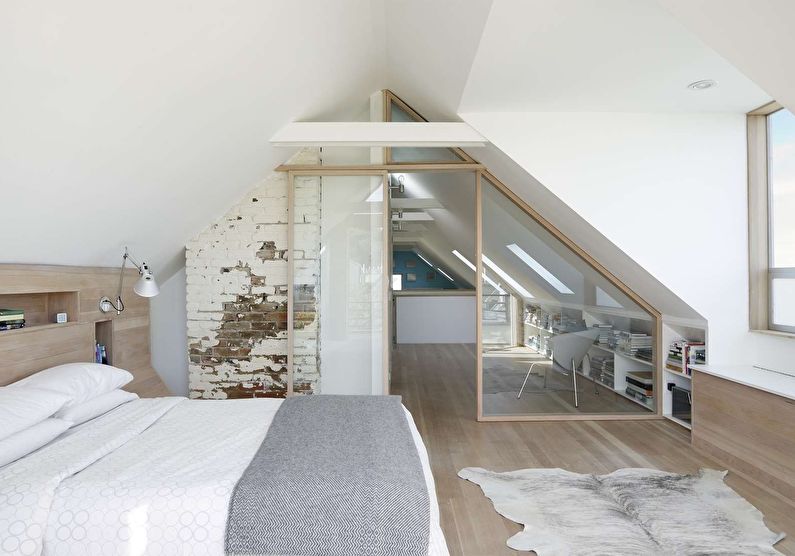
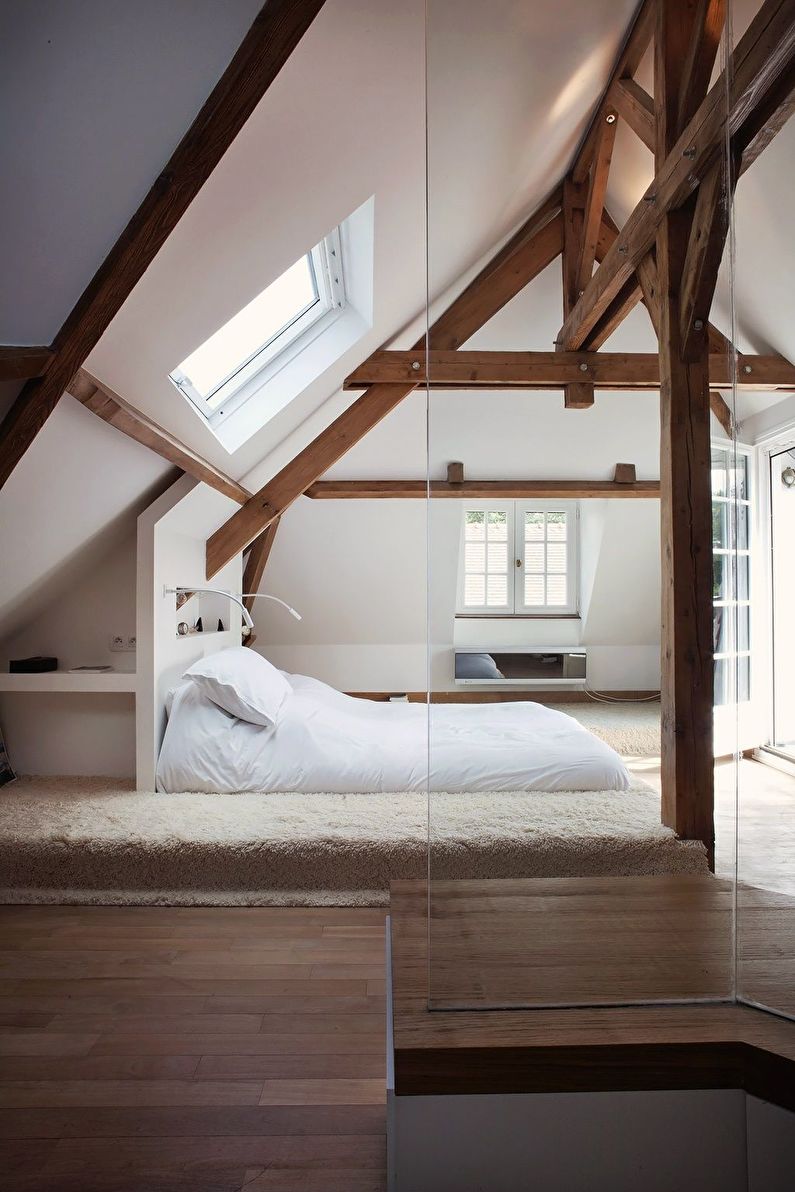
Design features of glass partitions
Before choosing glass partitions for an apartment, it will not be superfluous to find out about their technical characteristics. So, depending on the installation mechanism, stationary, sliding and mobile walls are distinguished. By the type of canvas, they can be reinforced or all-glass.
Stationary partitions firmly attached to the top and bottom to metal rails mounted respectively in the ceiling and floor. As a rule, these are dimensional and rather heavy structures, therefore, all work with them should be carried out by specialists.
It is advisable to provide for the installation of a permanent glass wall at the planning stage of repairs, and to perform it after all other finishing work is completed.
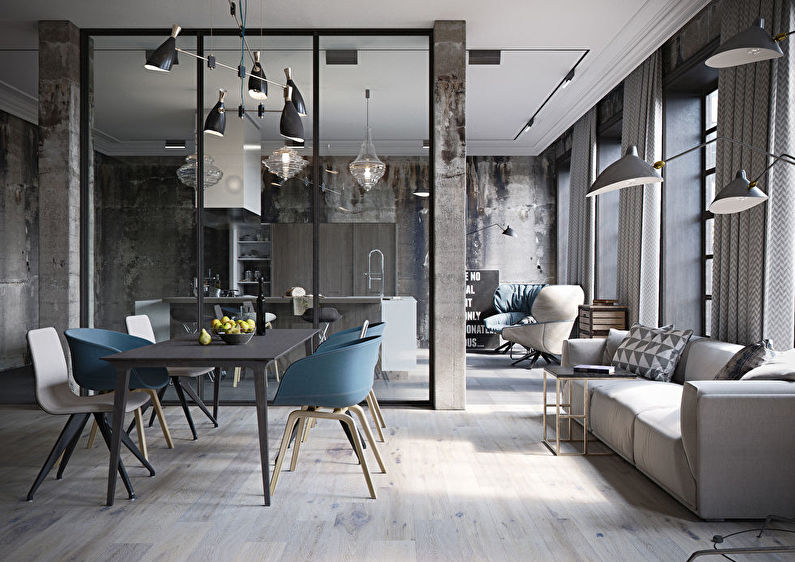
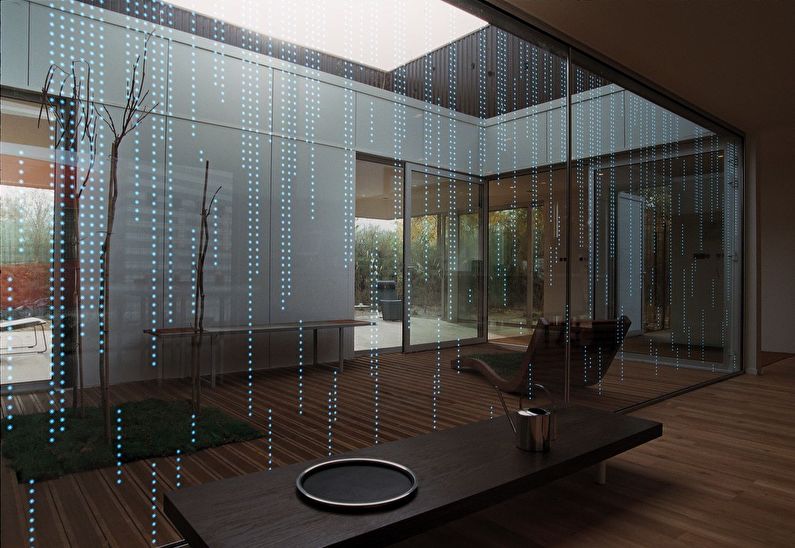
Sliding partitions Along with the zoning of the space, they serve as doors, and, if necessary, smoothly move to the side. Depending on the folding mechanism, it can be either a coupe system or an accordion.
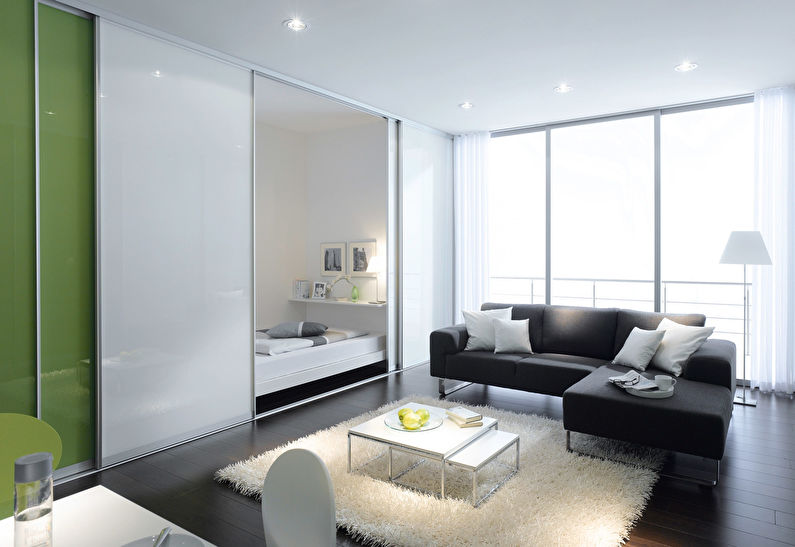
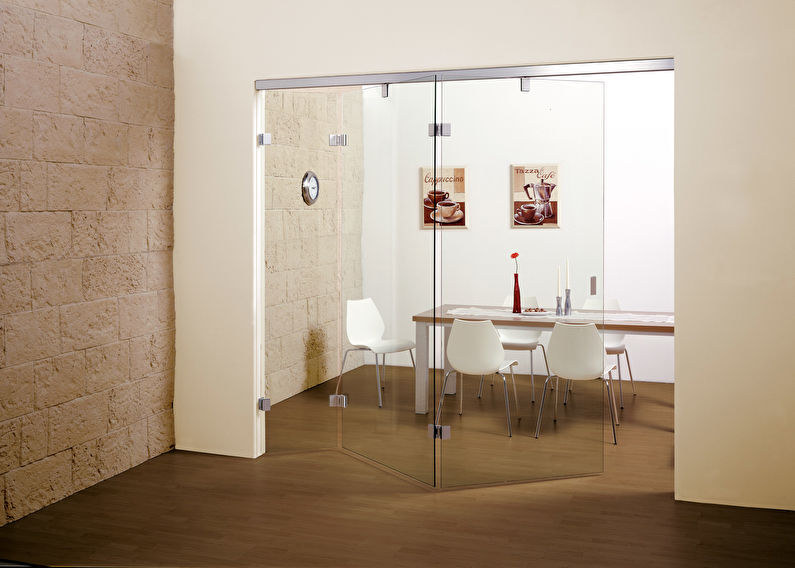
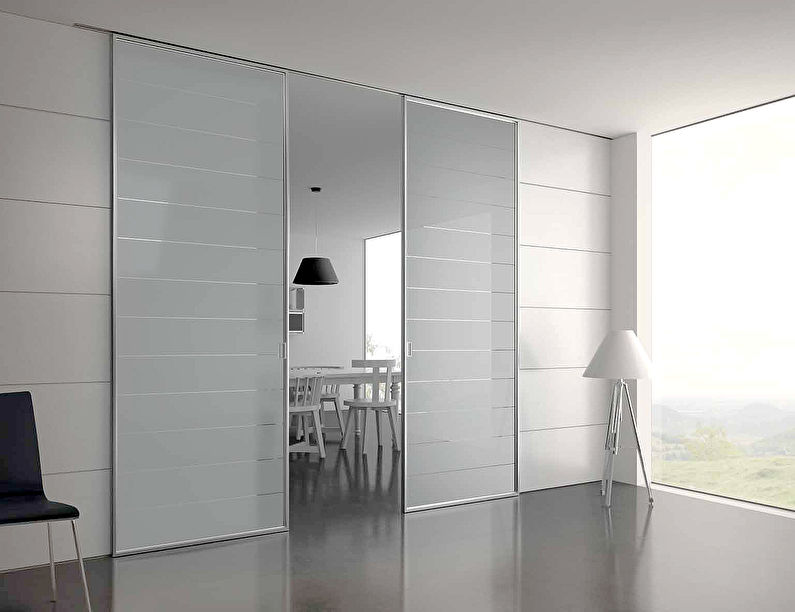
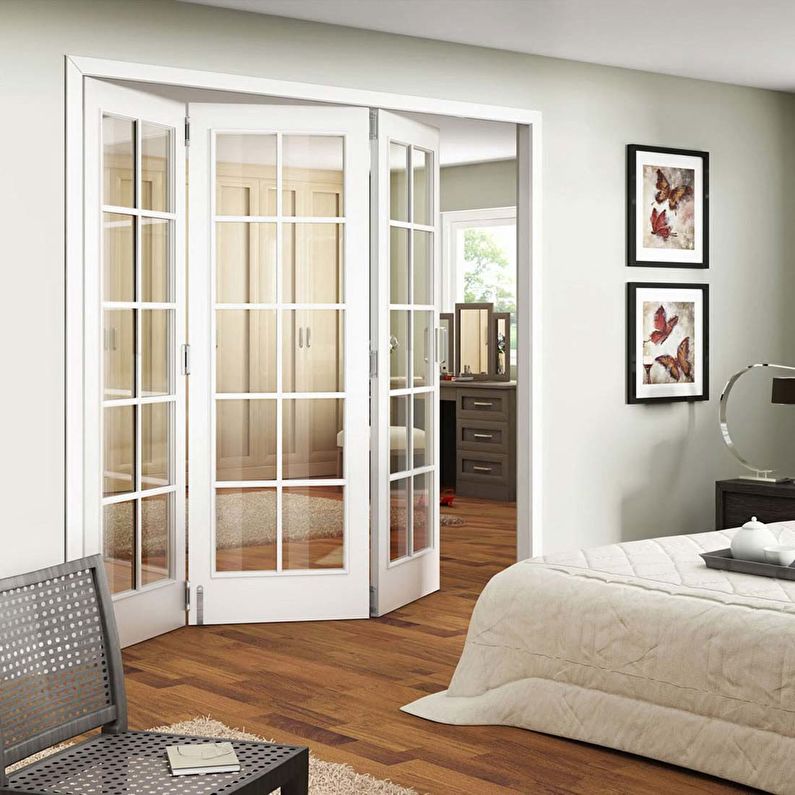
Mobile partitionsusually very light and compact. This can be portable plexiglass screens, folding structures, movable walls on castors. Such interior additions allow you to independently change the layout at least every day, in addition, they are quite easy to transport from one rental apartment to another.
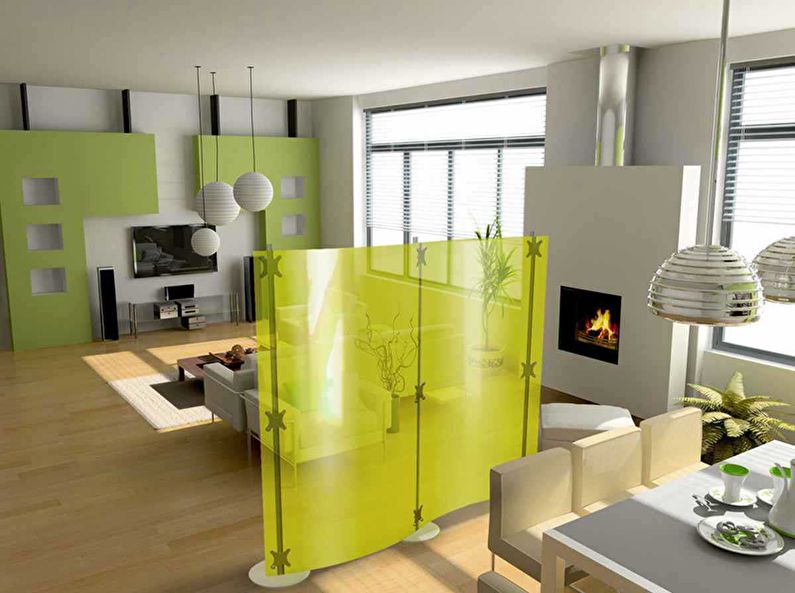
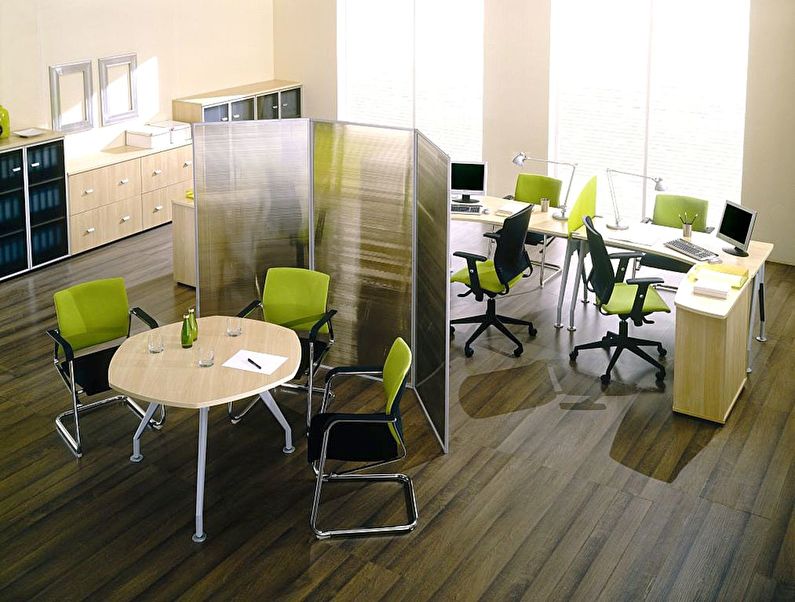
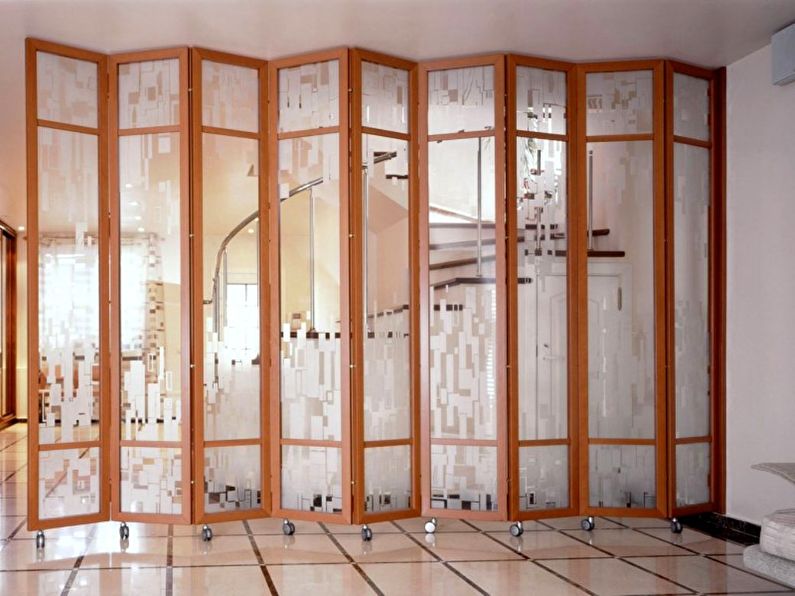
Reinforced partitions Look strong and stable due to the metal-plastic frames that fix the glass. They are less exposed to the risk of mechanical damage, do not rattle during sound resonance (loud noises, thunderstorm, large vehicles passing under the house), and if one element breaks, you will not have to change the entire canvas.
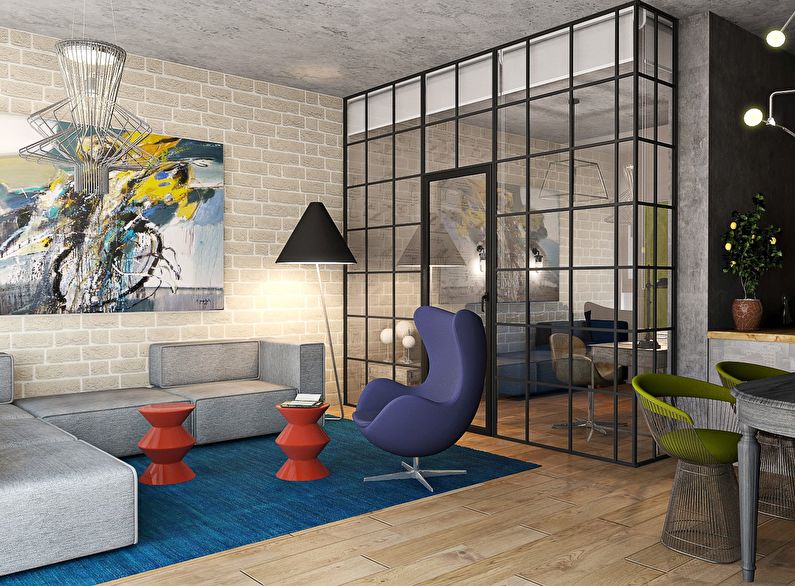
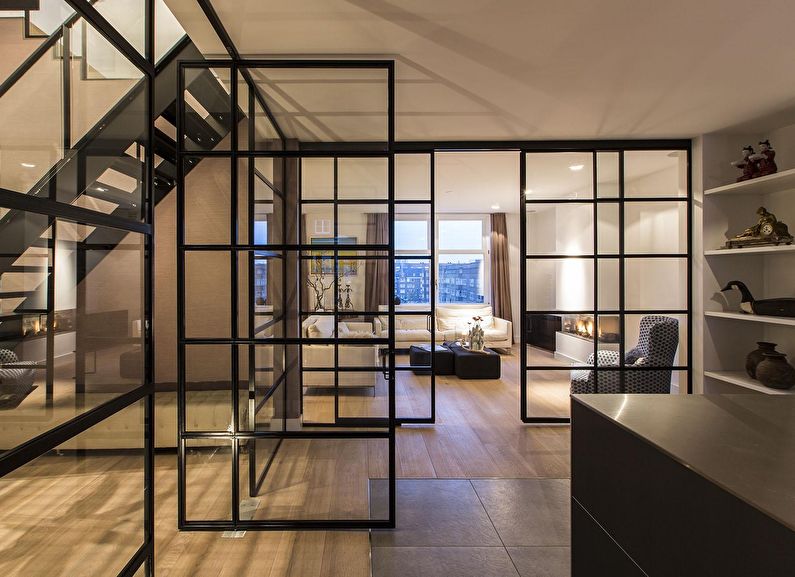
All-glass partitions - a real decoration of a modern interior. Glass panels ranging in size from 2-3 meters give the impression of an expensive and trendy design.
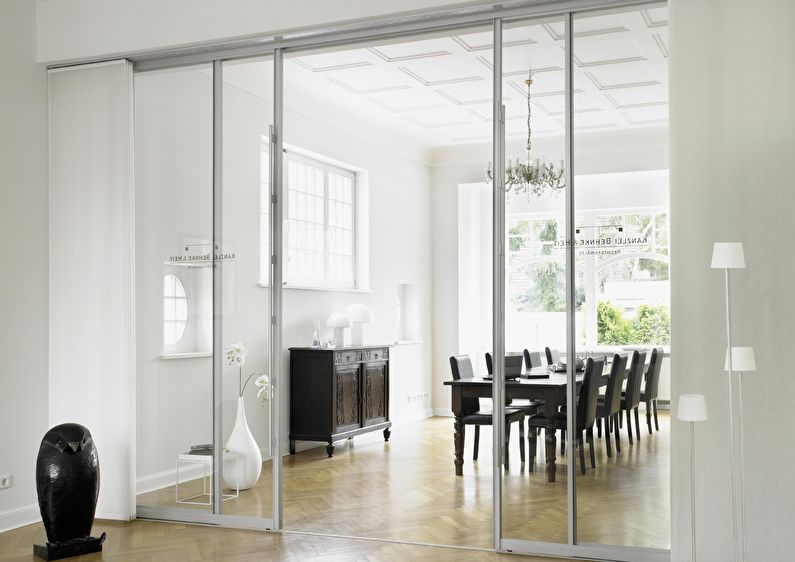
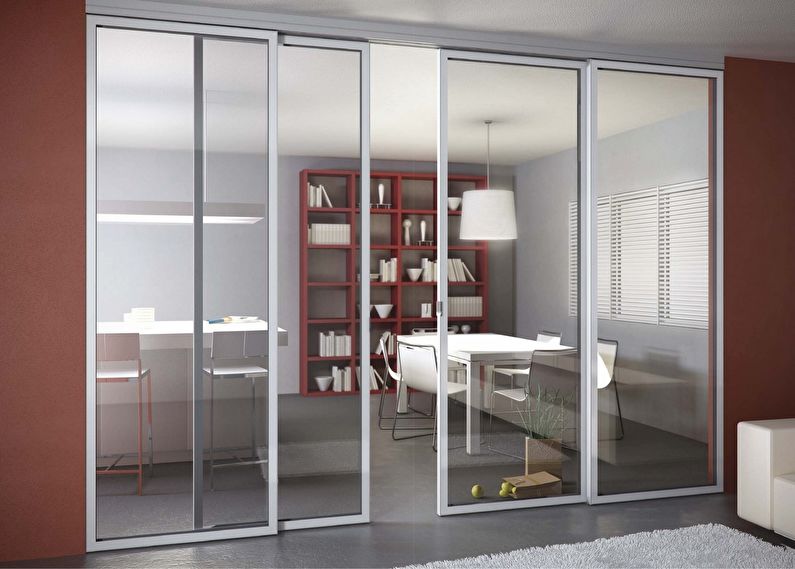
The aesthetic side of the issue
In addition to functionality and practicality, glass has always been appreciated for its unique beauty. This material is only comparable in quality to crystals, though it provides an incomparably larger field for creativity, creating an interesting play of light, textures and colors.
Transparent glass partitions look so light and weightless that it may seem as if they are completely gone. The only hint of the existence of the barrier is the thin borders of the paintings or the almost imperceptible frames around them.


Tinted glass protect from bright light and create a comfortable atmosphere in adjacent rooms. This option is more suitable for warm regions and apartments located on the south side of buildings.
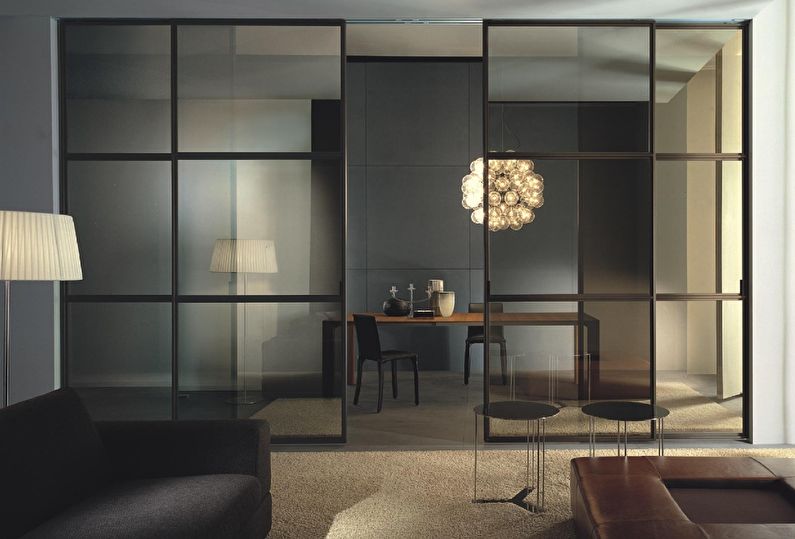
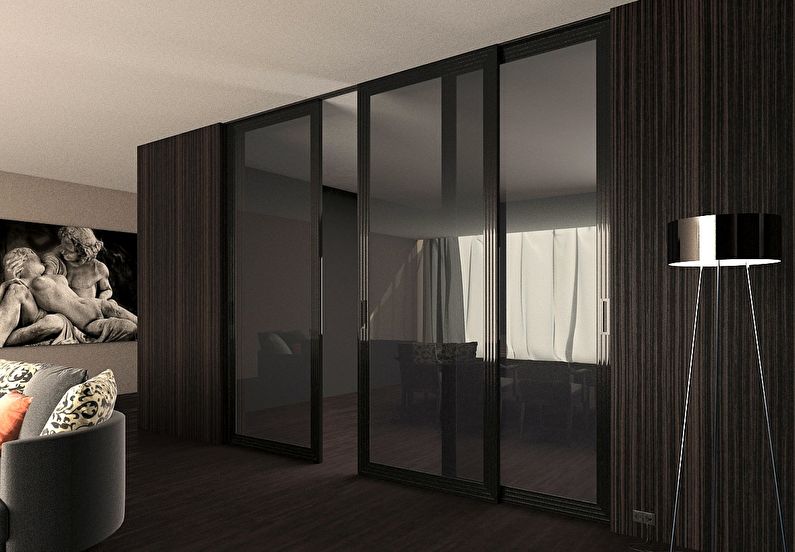
Frosted glass partitions hide the room from unnecessary views, allowing you to consider only the silhouettes. Moreover, their light transmittance can vary from 15 to 60%.
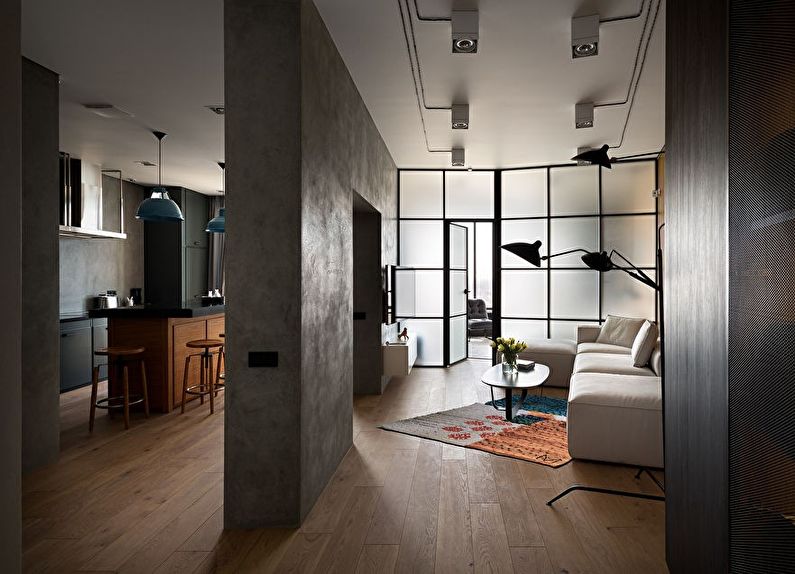

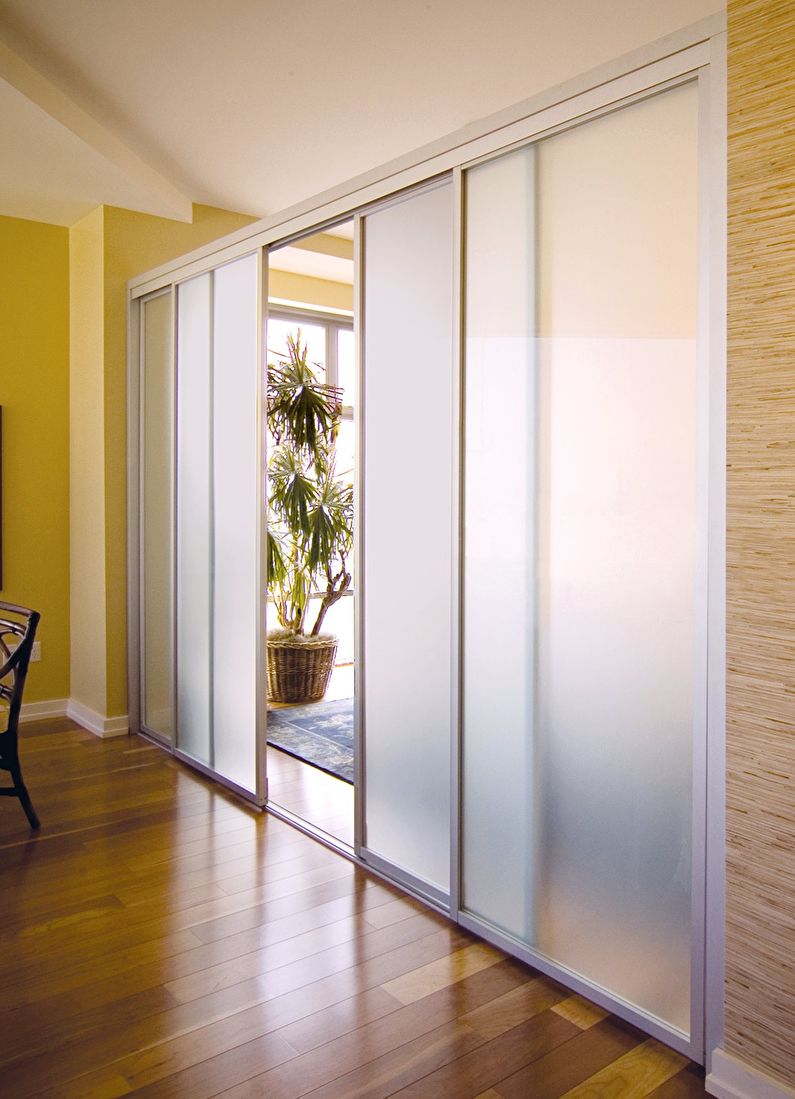
Corrugated glass It has a volumetric texture, so usually its thickness is more than transparent. Embossed elements refract light, so the outlines of objects are very blurred.
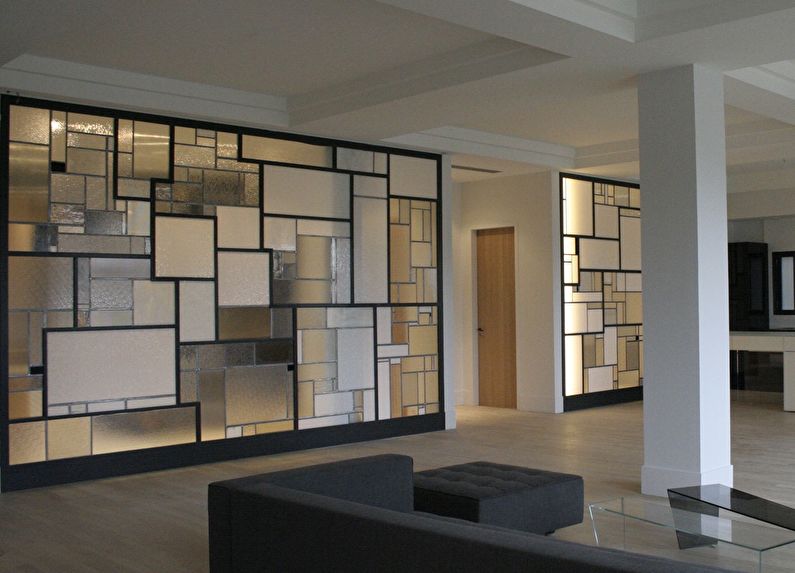

Sandblasting on glass remind frosty patterns and they look equally bewitching. Matte illustrations on a transparent background (or vice versa) can decorate any interior, just select an image to your liking.
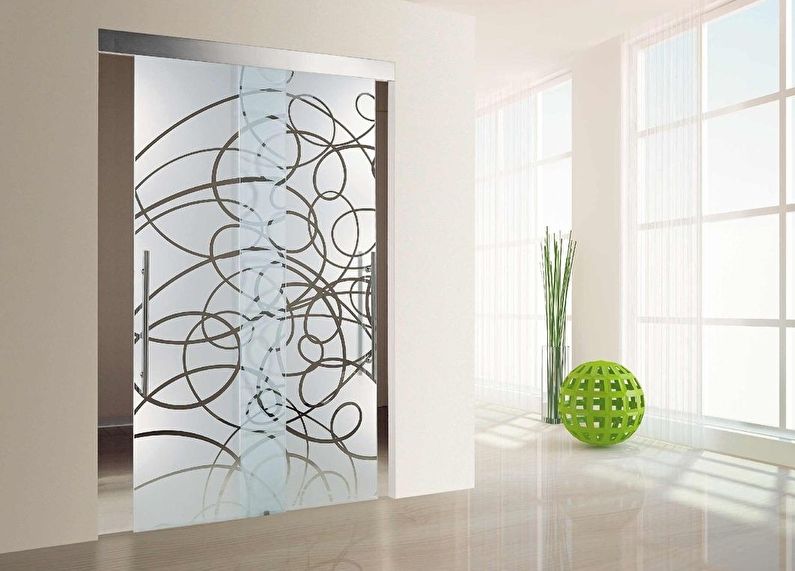
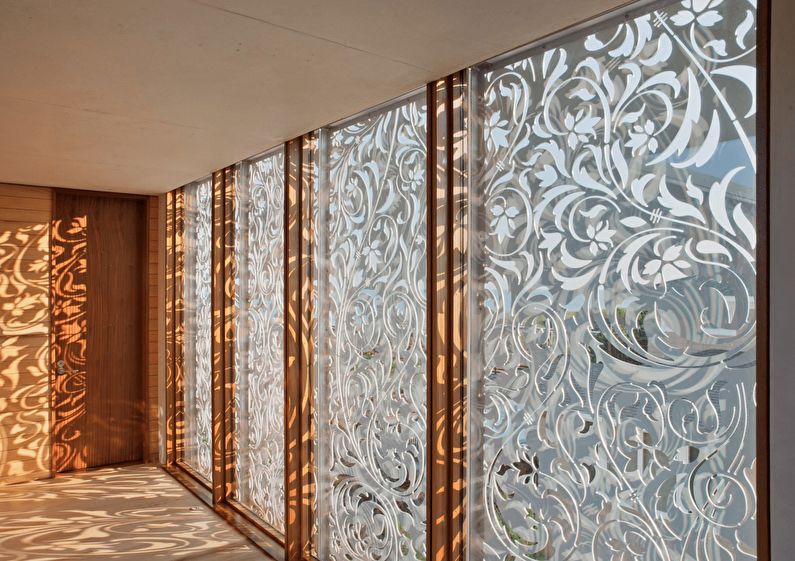
Stained glass - a whole art that has long been used to design luxurious palaces and religious buildings. So why not experiment with them in the apartment?
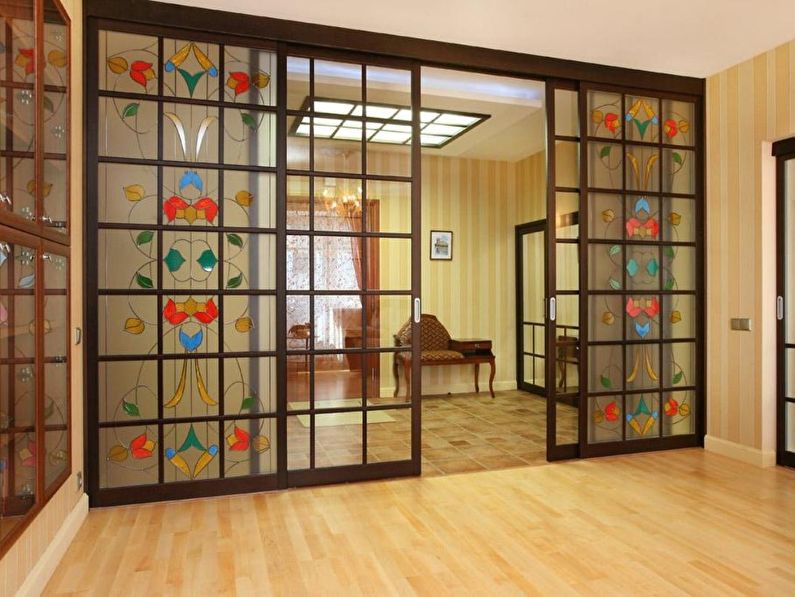
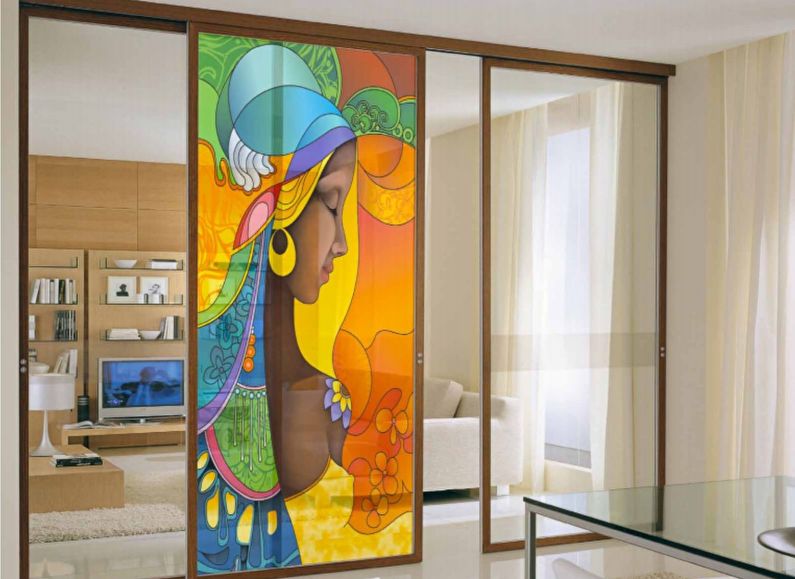

Partitions from glass blocks can also look beautiful and modern. The inner wall of glass “cubes” is a stable and solid construction, as durable as brickwork.
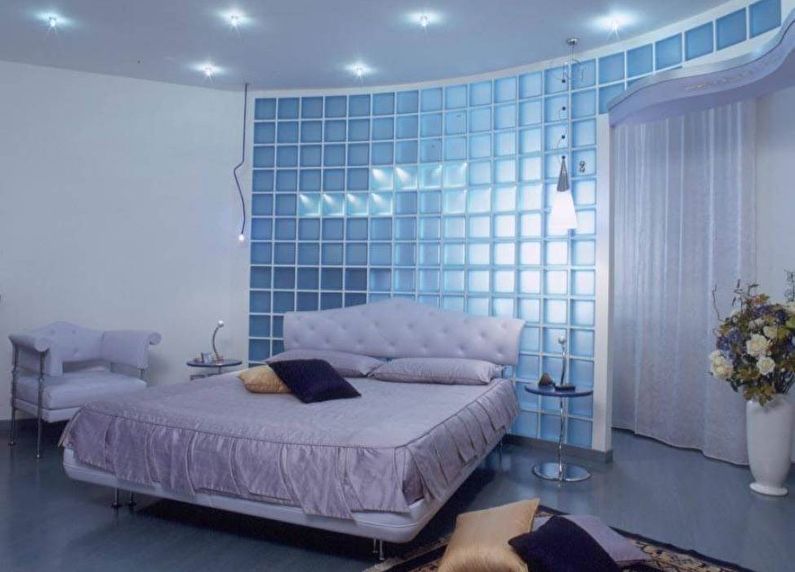
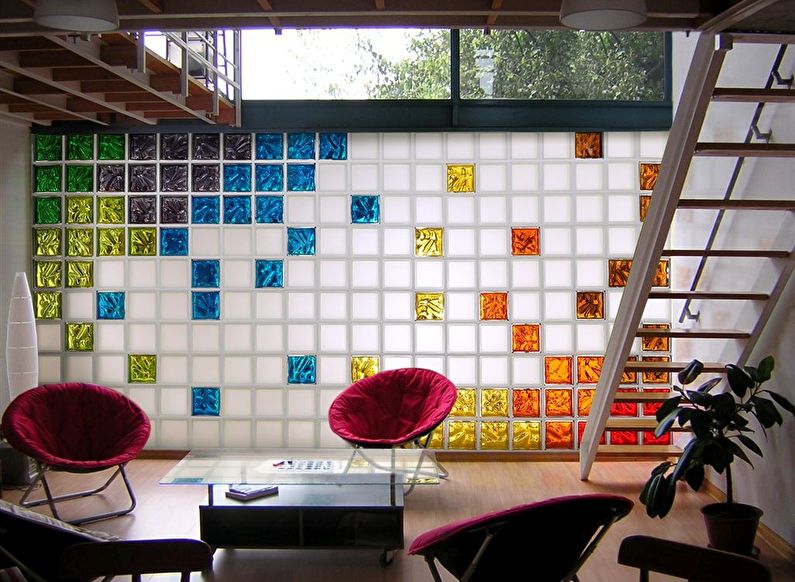
Use in different rooms
Glass partitions in the kitchen / dining room
Many people refuse the combined kitchen-living room because of fears that the smell during cooking will spread throughout the apartment. A sealed glass partition with a tightly closing door easily solves this issue.
At the same time, the kitchen becomes more spacious, the adjoining room - visually larger. And you can follow what is happening on the stove from the living room, without being distracted from watching the series.
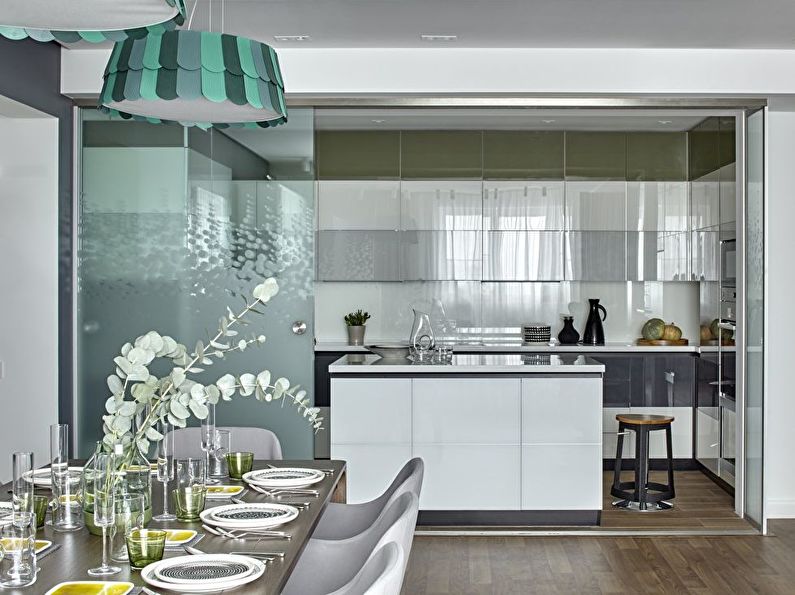
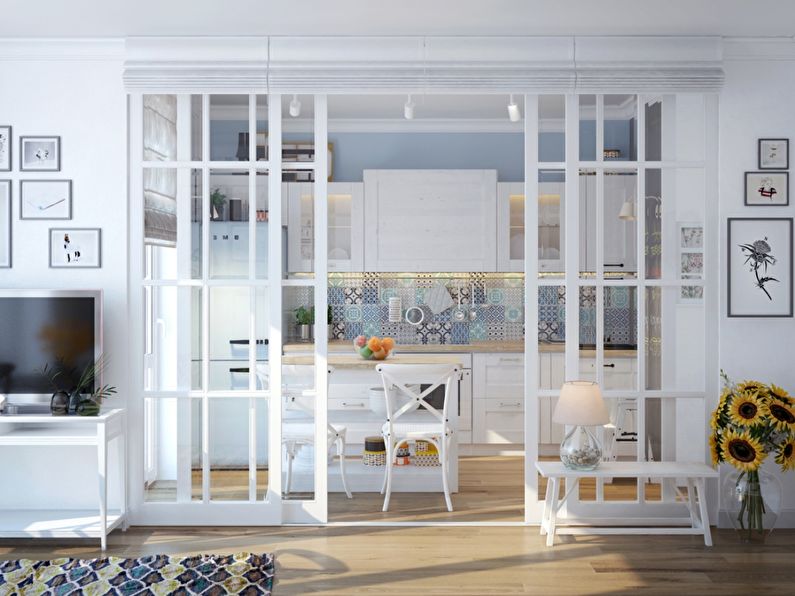

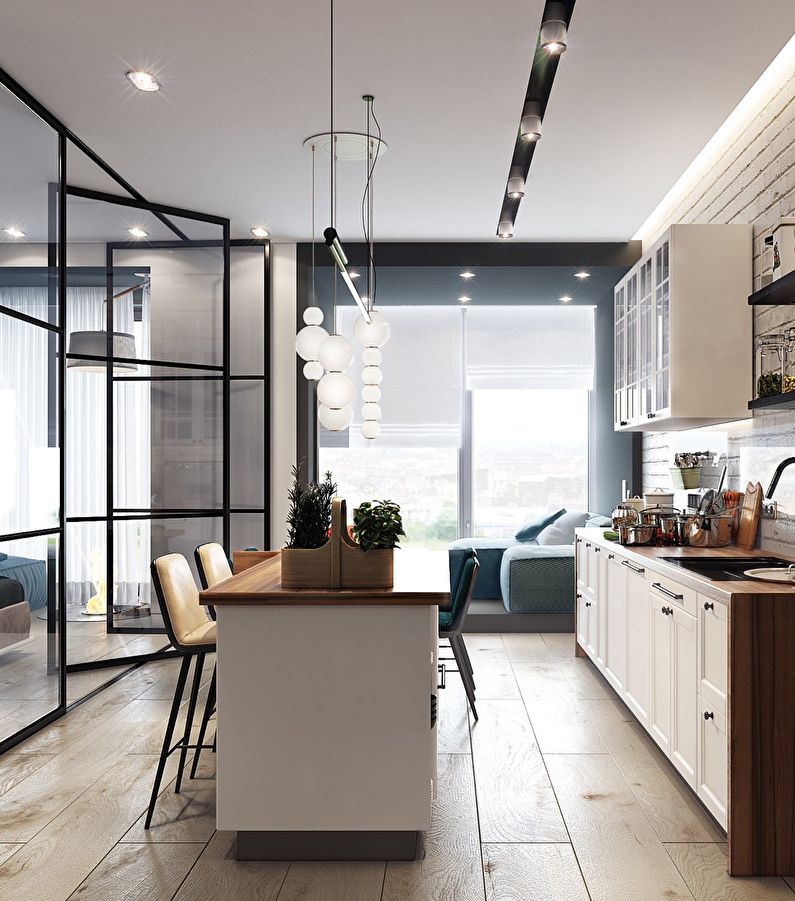
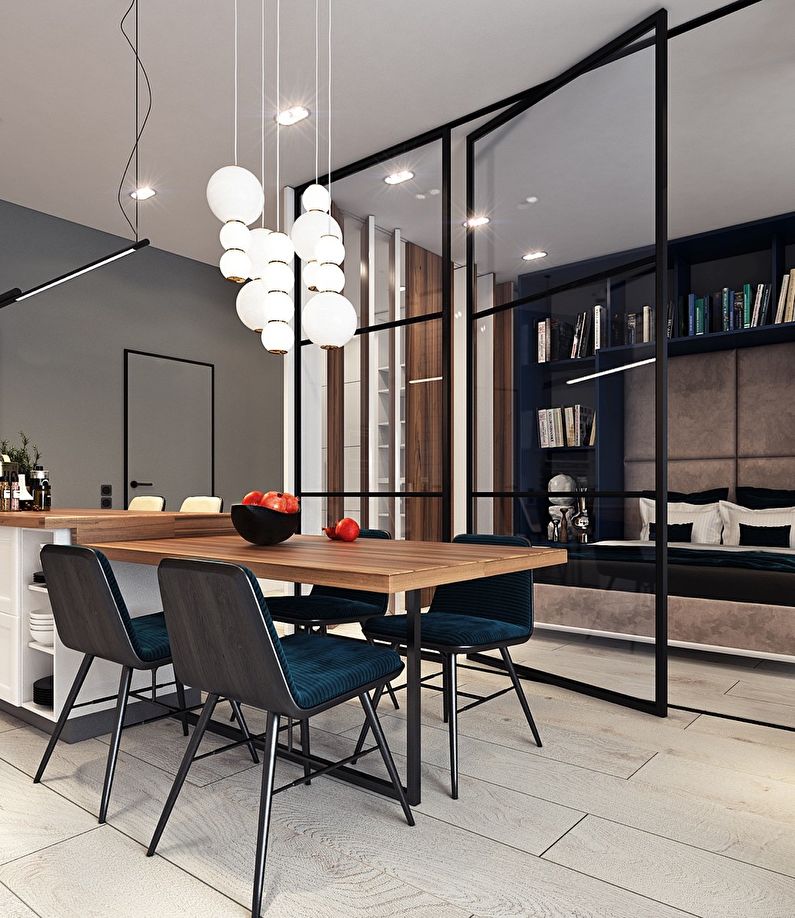
Glass partitions in the bedroom
It is not always possible to separate the sleeping area from the guest zone by a full wall, especially if it is a studio or a small one-room apartment. But just put a glass partition - and a secluded corner is ready.
For greater privacy at night, you can close it with a curtain, blinds or choose opaque glass (frosted, corrugated, tinted).
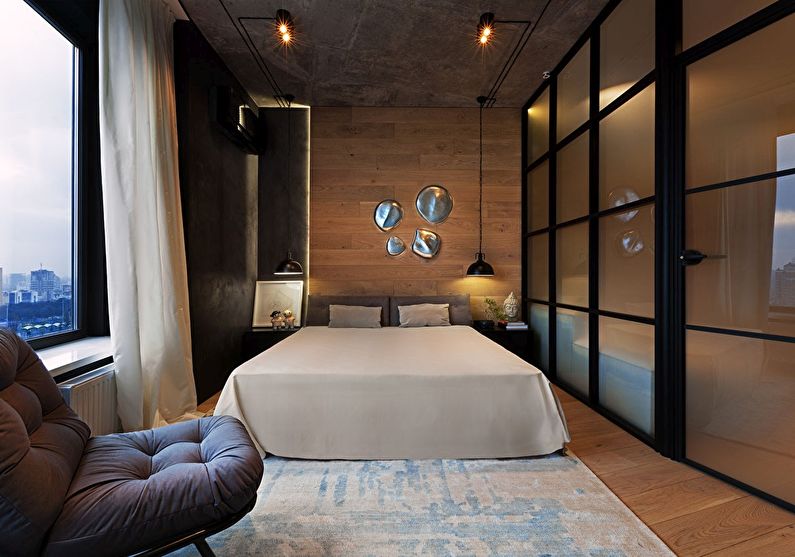

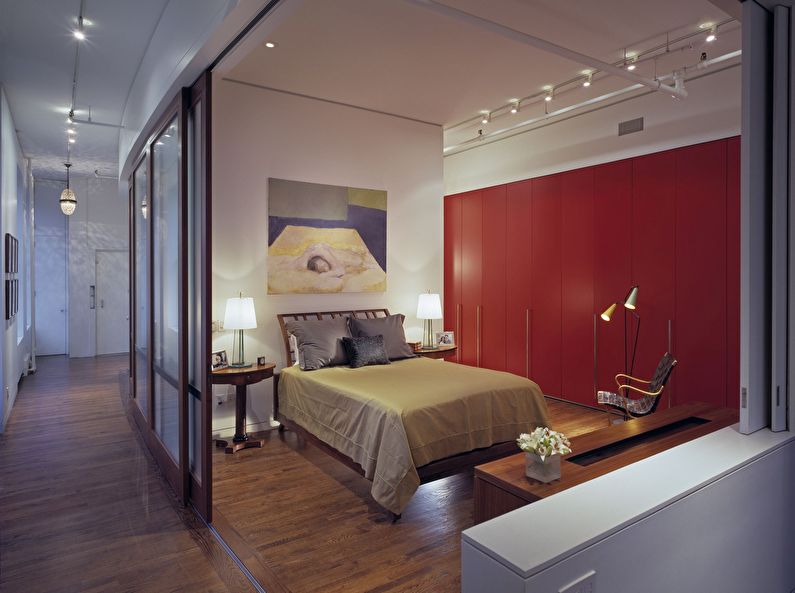

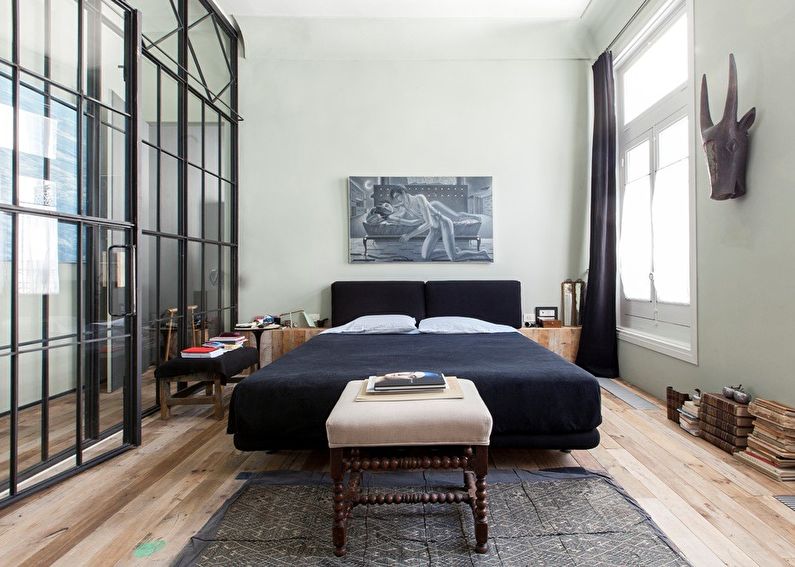
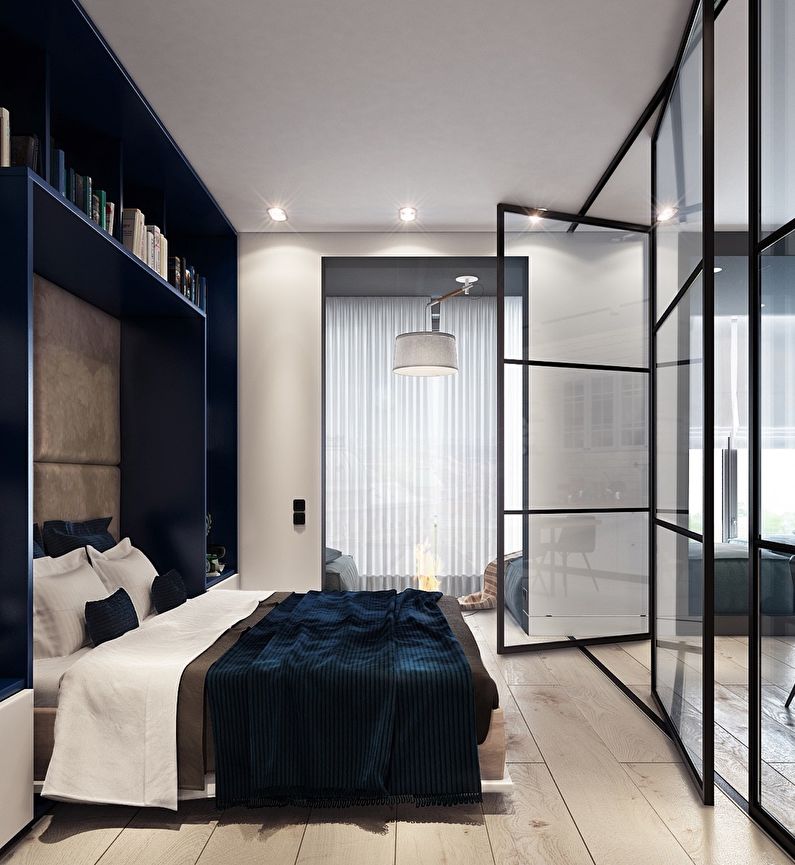
Glass partitions in the bathroom
Glass (although more often - acrylic) walls of a shower cabin do not surprise anyone for a long time. It is convenient and hygienic, because the glass is easy to clean, dries quickly, mold does not appear on it.
Given these excellent qualities, the designers of modern apartments decided to completely separate the bathrooms with glass, and not some other partitions. Of course, the transparent walls of the bathroom may seem like a strange solution, but why not make them invisible - for example, from tinted, mirror or completely frosted glass?
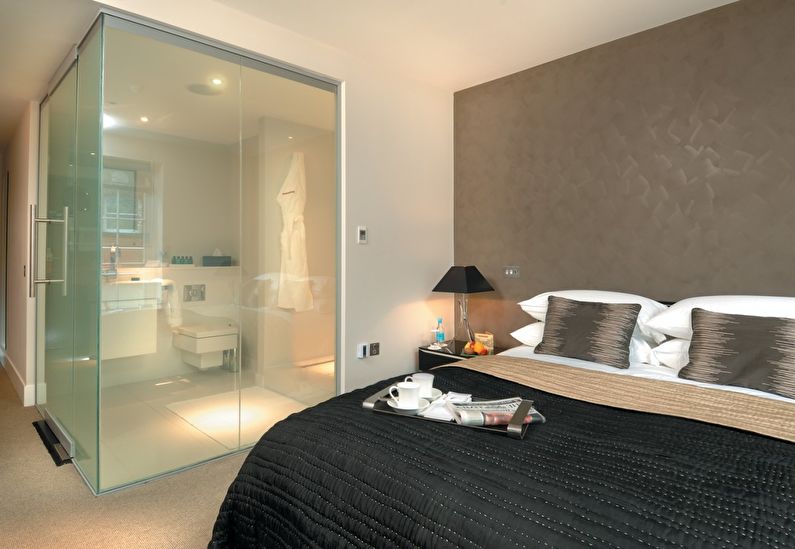
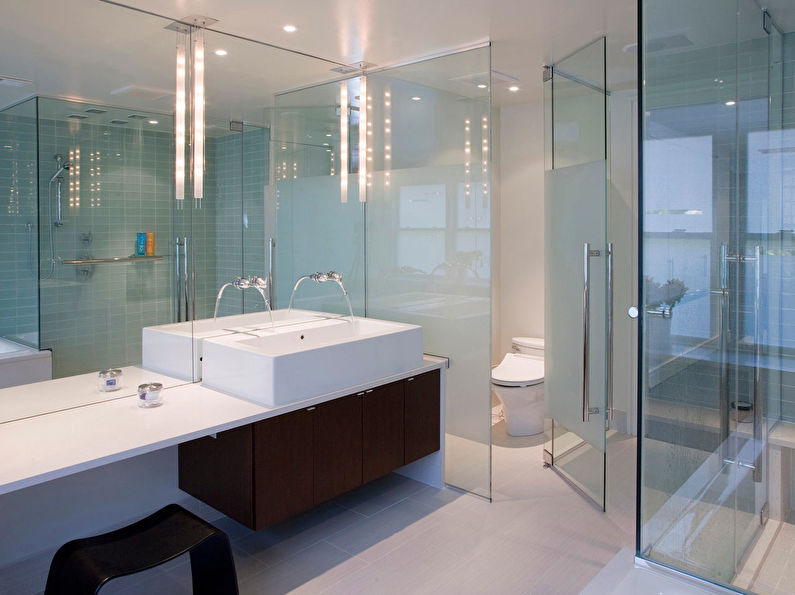

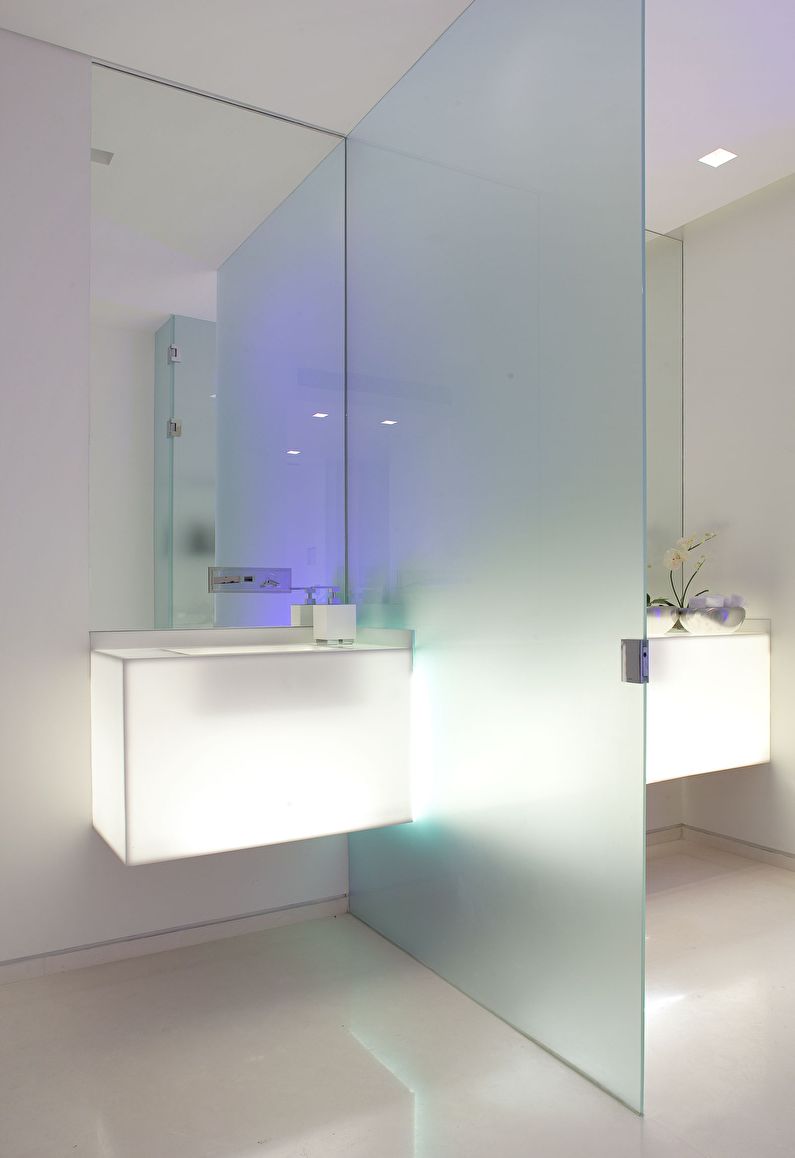
Glass partitions in the living room
Even a very small living room, zoned by glass partitions from the hallway, kitchen or bedroom, will look spacious and open. Another interesting option is to protect, in the same way, access to the loggia by setting up a relaxation corner or a mini greenhouse there.

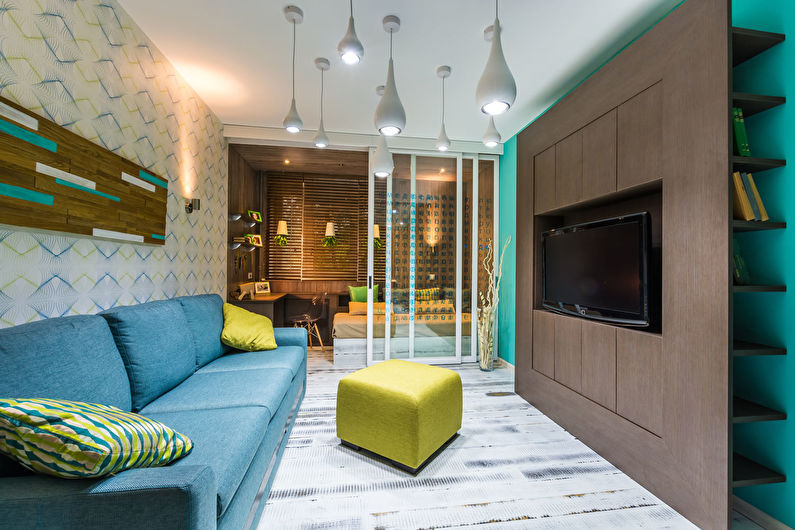
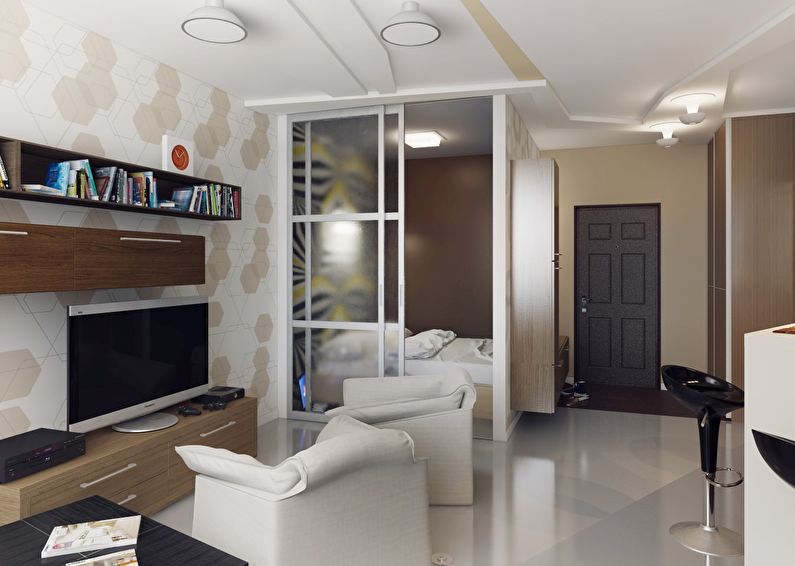
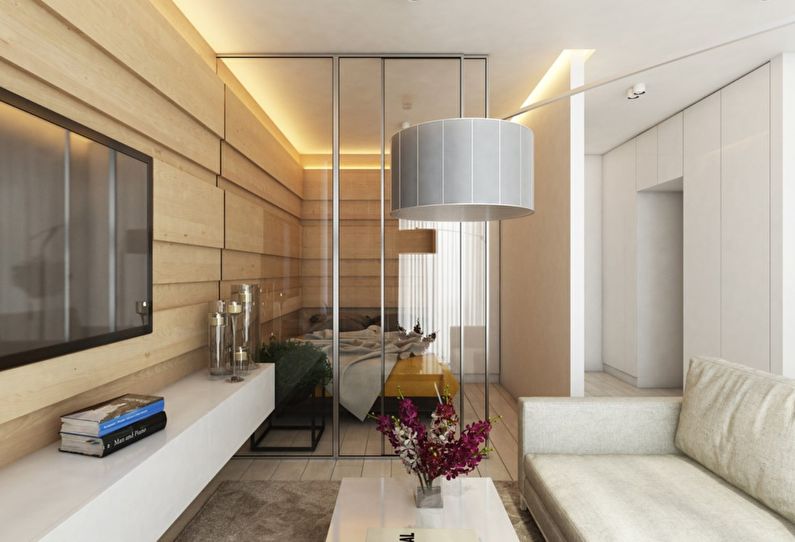
Glass partitions in the hallway / corridor
In most apartments, the entrance hall and corridor are tightly insulated from sunlight. Installing a glass partition instead of one of the internal walls or at least a transparent sliding panel in the extended doorway will provide good natural lighting, creating a welcoming atmosphere right from the threshold.
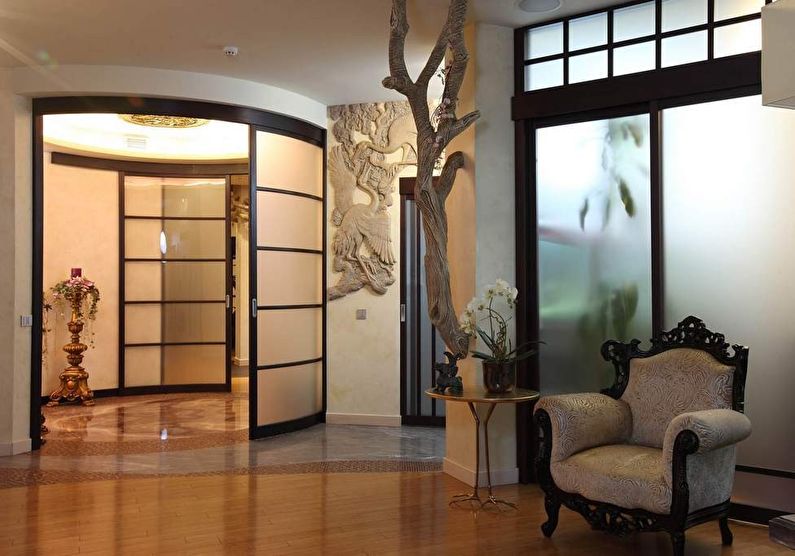
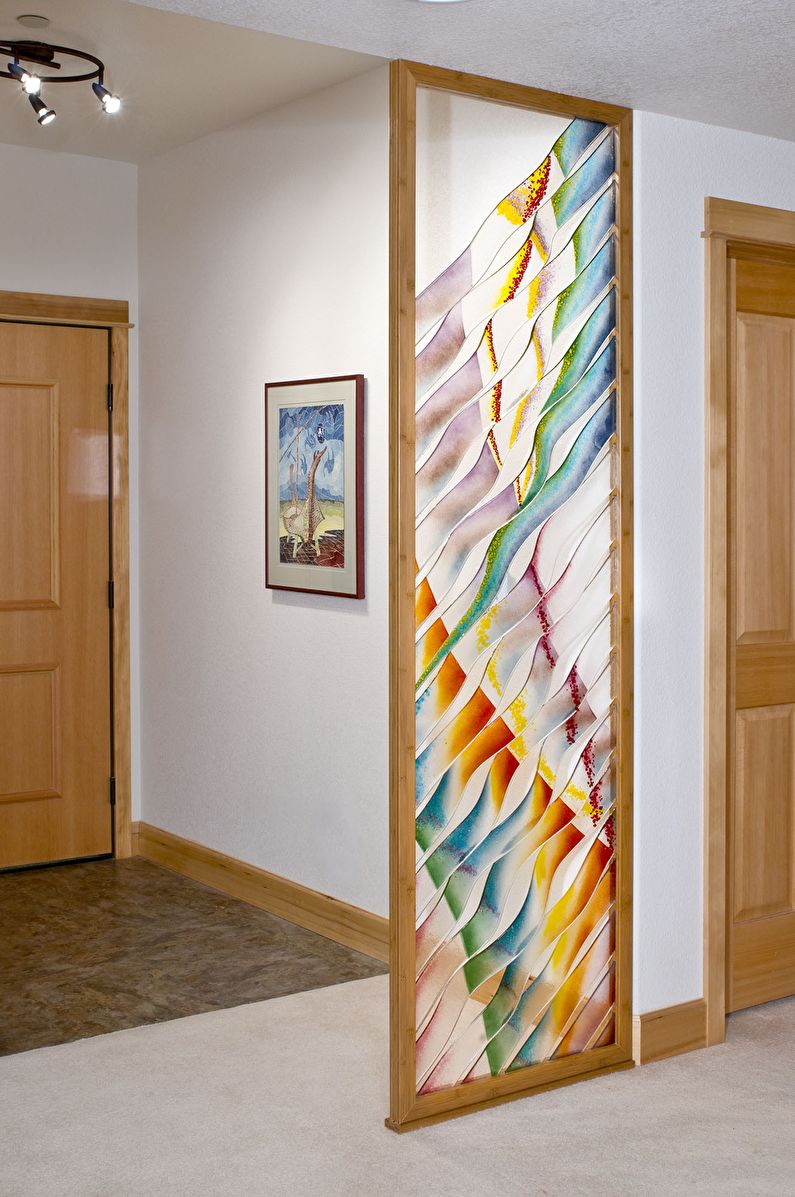

Video: Partitions made of glass in the interior of the apartment
